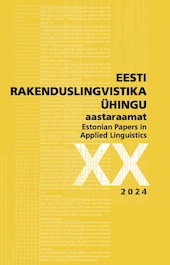Nutiseade kui leitud võlukepp? Vanemate vaade väikelaste L1-st erineva keele omandamisele YouTube’i abil
A smart device as a magic wand? Parents’ perspective on the impact of YouTube on young children’s second language acquisition
Author(s): Merje Miliste, Natalja ZaguraSubject(s): Foreign languages learning, Media studies, Language acquisition, Psycholinguistics
Published by: Eesti Rakenduslingvistika Ühing (ERÜ)
Keywords: early second language learning; language acquisition; smart devices; YouTube; English;
Summary/Abstract: The present article explores the role of technology in shaping language environments and supporting the acquisition of multiple languages among young children and preschoolers. The study focuses on a case where children from an Estonian-speaking family, pseudonymised as Karola and Oskar, began expressing themselves in English in gaming situations, having previously encountered the language primarily through entertainment content on YouTube. Karola started emulating English-speaking YouTubers at the age of five and even created her own videos, while Oskar mainly used English when playing with his toys.The study aims to answer three research questions: when and how the children started using smart devices; how their choices in online content evolved as the children grew; and what roles the parents played in this process. To better understand the phenomenon of YouTube as a digital learning space, a semi-structured non-standardized paired interview was conducted with the children's parents. The goal was to investigate how it is possible to support the acquisition of a language different from L1 at home using smart devices and YouTube. The analysis of the interviews employed qualitative content analysis methods. The results reveal that children started watching short cartoons and animated songs in L1 at the age of one or two. However, as the number of appropriate resources in Estonian on YouTube was limited, they soon opted for cartoons and videos in English. As children grew, they selected the content to watch on the basis of the characters they could relate to. The language in the videos also progressed from simple clearly pronounced words and phrases to fluent authentic use of English. The analysis indicated that parental roles are dynamic and evolve alongside the child's cognitive, social, and linguistic development, ranging from supervision during media consumption to active mentorship.
Journal: Eesti Rakenduslingvistika Ühingu aastaraamat
- Issue Year: 2024
- Issue No: 20
- Page Range: 165-180
- Page Count: 16
- Language: Estonian

